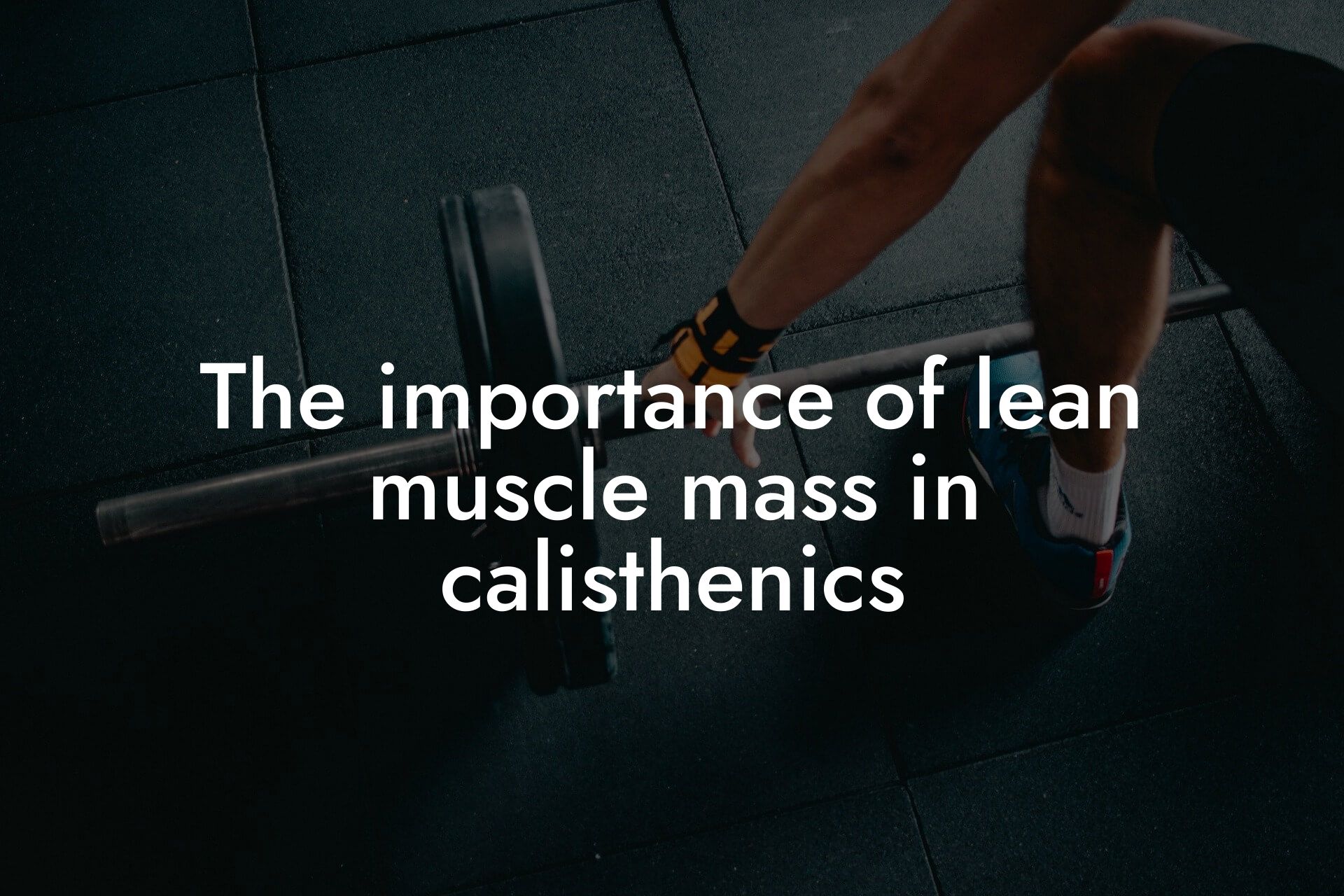As a high-earning professional, you understand the importance of maintaining a strong and lean physique. Calisthenics, a form of exercise that focuses on bodyweight movements, requires a specific balance of strength and body fat to achieve optimal performance. A good strength-to-weight ratio is crucial in calisthenics, as it enables you to perform movements efficiently and effectively. In this article, we will explore the importance of reducing body fat to improve your strength-to-weight ratio in calisthenics and provide you with a comprehensive guide to achieve your goals.
Table of Contents
- The Benefits of a Low Body Fat Percentage
- How to Calculate Your Body Fat Percentage
- Setting Realistic Goals for Reducing Body Fat
- Nutrition Strategies for Reducing Body Fat
- Training Strategies for Reducing Body Fat
- Supplementation for Reducing Body Fat
- Monitoring Progress and Staying Motivated
- Frequently Asked Questions
The Benefits of a Low Body Fat Percentage
Maintaining a low body fat percentage is essential for optimal performance in calisthenics. When you have excess body fat, it can hinder your movements, making it more challenging to perform exercises efficiently. A low body fat percentage offers several benefits, including:
• Increased strength-to-weight ratio: With less body fat, you'll be able to lift and move your body more efficiently, resulting in improved overall strength.
• Enhanced athletic performance: A leaner physique enables you to perform exercises with more power, speed, and agility.
• Better body composition: A low body fat percentage reveals the muscle mass you've worked hard to build, giving you a more toned and athletic appearance.
• Improved overall health: Maintaining a healthy body fat percentage reduces the risk of chronic diseases, such as diabetes and heart disease.
How to Calculate Your Body Fat Percentage
Calculating your body fat percentage is crucial to understanding your current physique and setting realistic goals. There are several methods to measure body fat, including:
• Dual-Energy X-ray Absorptiometry (DEXA): A non-invasive, highly accurate method that uses X-rays to measure bone density and body composition. At Tano Performance Group, we use DEXA machines to provide our clients with a comprehensive body assessment.
• Hydrostatic Weighing: A method that measures body density by weighing you underwater.
• Skinfold Measurements: A technique that measures the thickness of your skin folds at specific points on your body.
• Bioelectrical Impedance Analysis (BIA): A non-invasive method that uses a device to send an electrical current through your body to estimate body fat percentage.
Setting Realistic Goals for Reducing Body Fat
Before starting your fat loss journey, it's essential to set realistic goals. Aim to lose 0.5-1% body fat per week for a sustainable and healthy weight loss. This may seem slow, but it's a more maintainable pace that reduces the risk of muscle loss and plateaus.
For example, if you currently have a body fat percentage of 20%, aim to reduce it to 18% over the next 8-12 weeks. This will give you a more toned and athletic appearance, while also improving your strength-to-weight ratio.
Nutrition Strategies for Reducing Body Fat
A well-planned nutrition strategy is crucial for reducing body fat and improving your strength-to-weight ratio. Focus on the following principles:
• Caloric Deficit: Create a caloric deficit of 500-1000 calories per day to promote weight loss while preserving muscle mass.
• Macronutrient Balance: Aim for a balanced diet consisting of 1.6-2.2 grams of protein per kilogram of body weight, 2-3 grams of carbohydrates per kilogram of body weight, and 0.5-1 gram of healthy fats per kilogram of body weight.
• Meal Frequency: Eat 4-6 main meals and 2-3 snacks per day to keep your metabolism boosted and prevent muscle loss.
• Hydration: Drink at least 8-10 glasses of water per day to aid in digestion and nutrient absorption.
Training Strategies for Reducing Body Fat
A well-structured training program is essential for reducing body fat and improving your strength-to-weight ratio. Focus on the following principles:
• Progressive Overload: Gradually increase the intensity of your workouts by adding weight, reps, or sets over time to challenge your muscles and promote growth.
• High-Intensity Interval Training (HIIT): Incorporate HIIT workouts 2-3 times per week to boost your metabolism and burn fat.
• Resistance Training: Focus on compound exercises like squats, deadlifts, and bench press to build muscle mass and increase your strength-to-weight ratio.
• Active Recovery: Incorporate low-intensity cardio and stretching exercises on your rest days to aid in recovery and reduce muscle soreness.
Supplementation for Reducing Body Fat
While nutrition and training are the foundation of reducing body fat, supplements can aid in your journey. Consider the following supplements:
• Protein Powder: A convenient way to increase your protein intake and support muscle growth.
• Creatine: A natural substance that increases strength and endurance.
• Branched-Chain Amino Acids (BCAAs): Amino acids that reduce muscle soreness and aid in recovery.
• Green Tea Extract: A natural fat burner that boosts your metabolism and aids in weight loss.
Monitoring Progress and Staying Motivated
Monitoring your progress and staying motivated are crucial to achieving your goals. Take progress photos, measurements, and track your workouts to see how far you've come. Celebrate your small victories and don't be too hard on yourself when you encounter setbacks.
At Tano Performance Group, we understand the importance of having a support system. Our team of experts is dedicated to providing you with personalized guidance and support to help you achieve your goals.
Remember, reducing body fat and improving your strength-to-weight ratio takes time, patience, and dedication. Stay committed to your goals, and with the right nutrition, training, and mindset, you'll be on your way to achieving a leaner, stronger, and more athletic physique.
Frequently Asked Questions
What is the ideal body fat percentage for calisthenics?
For calisthenics, a body fat percentage between 10-15% for men and 15-20% for women is considered ideal. This range allows for a good balance between strength and aesthetics. However, it's essential to note that body fat percentage is just one aspect of overall fitness, and other factors like muscle mass, bone density, and overall health should also be considered.
Why is reducing body fat important for calisthenics?
Reducing body fat is crucial for calisthenics because it allows for a better strength-to-weight ratio. When you have excess body fat, it can hinder your performance and make exercises more challenging. By reducing body fat, you'll be able to perform exercises with more efficiency and effectiveness, leading to improved overall fitness.
How does body fat affect my strength-to-weight ratio?
Body fat affects your strength-to-weight ratio by adding weight without contributing to your overall strength. The more body fat you have, the more weight you'll need to lift and move around, making exercises more challenging. By reducing body fat, you'll be able to maintain or even increase your strength while decreasing your overall weight, leading to a better strength-to-weight ratio.
What are the benefits of having a low body fat percentage?
Having a low body fat percentage can provide numerous benefits, including improved athletic performance, increased muscle definition, enhanced overall health, and a reduced risk of chronic diseases like diabetes and heart disease. Additionally, a low body fat percentage can also boost confidence and self-esteem.
How can I measure my body fat percentage?
There are several ways to measure body fat percentage, including dual-energy X-ray absorptiometry (DXA), hydrostatic weighing, and skinfold measurements. You can also use body fat calipers to estimate your body fat percentage. It's essential to consult with a healthcare professional or certified fitness expert to ensure accurate measurements.
What is the difference between lean body mass and body fat percentage?
Lean body mass refers to the amount of muscle mass, bone density, and other non-fat tissues in your body. Body fat percentage, on the other hand, refers to the percentage of your body weight that is composed of fat. Having a high lean body mass and a low body fat percentage is ideal for overall fitness and athletic performance.
Can I lose body fat too quickly?
Yes, losing body fat too quickly is not healthy and may not be sustainable. Aiming to lose 1-2 pounds of body fat per week is a more realistic and healthy goal. Losing weight too quickly can also lead to muscle loss, which can negatively impact your strength-to-weight ratio.
How does diet affect my body fat percentage?
Diet plays a crucial role in maintaining or reducing body fat percentage. A balanced diet that is high in protein, moderate in complex carbohydrates, and low in unhealthy fats can help support weight loss and muscle growth. Additionally, staying hydrated and limiting processed foods and added sugars can also contribute to a healthy body fat percentage.
What are the best exercises for reducing body fat?
The best exercises for reducing body fat are those that combine strength training and cardio, such as burpees, jump squats, and mountain climbers. High-intensity interval training (HIIT) can also be effective for burning fat and improving cardiovascular health. Additionally, incorporating exercises that target multiple muscle groups at once, such as squats and lunges, can help increase your metabolism and burn more calories.
How often should I exercise to reduce body fat?
Aiming to exercise at least 3-4 times per week, with at least one day of rest in between, can help support weight loss and muscle growth. However, it's essential to listen to your body and adjust your exercise frequency based on your individual needs and goals.
Can I reduce body fat through cardio exercises alone?
While cardio exercises can be effective for burning calories and improving cardiovascular health, they may not be enough to reduce body fat percentage on their own. Incorporating strength training exercises that target multiple muscle groups can help increase your metabolism and burn more calories at rest, leading to a more significant reduction in body fat percentage.
How does stress affect my body fat percentage?
Chronic stress can increase the production of cortisol, a hormone that promotes fat storage around the midsection. Additionally, stress can lead to poor eating habits and a lack of motivation to exercise, making it more challenging to reduce body fat percentage. Engaging in stress-reducing activities like yoga or meditation can help mitigate the negative effects of stress on body fat percentage.
Can I reduce body fat percentage through supplements alone?
While certain supplements like protein powder and creatine can support muscle growth and recovery, they should not be relied upon as the sole means of reducing body fat percentage. A healthy diet and regular exercise routine are essential for achieving and maintaining a low body fat percentage.
How long does it take to notice changes in body fat percentage?
The time it takes to notice changes in body fat percentage can vary depending on individual factors such as starting point, diet, and exercise routine. However, with a consistent and well-structured approach, you can start to notice changes in as little as 4-6 weeks.
What are the risks of having too little body fat?
Having too little body fat can lead to a range of health problems, including osteoporosis, hormone imbalances, and a weakened immune system. Additionally, having too little body fat can also negatively impact athletic performance and overall health.
How can I maintain my body fat percentage once I've reached my goal?
Maintaining your body fat percentage requires a continued commitment to a healthy diet and regular exercise routine. It's essential to stay hydrated, listen to your body, and make adjustments as needed to ensure you're meeting your nutritional and caloric needs.
What role does sleep play in reducing body fat percentage?
Sleep plays a critical role in reducing body fat percentage by regulating hormones that control hunger and fullness, as well as supporting muscle recovery and growth. Aiming for 7-9 hours of sleep per night can help support weight loss and overall health.
Can I reduce body fat percentage without sacrificing muscle mass?
Yes, it is possible to reduce body fat percentage without sacrificing muscle mass. This requires a careful balance of diet and exercise, focusing on nutrient-dense foods and strength training exercises that target multiple muscle groups.
How does age affect my ability to reduce body fat percentage?
As we age, our metabolism slows down, making it more challenging to reduce body fat percentage. However, with a consistent and well-structured approach to diet and exercise, it is still possible to achieve and maintain a low body fat percentage at any age.
What are the benefits of working with a personal trainer or fitness coach?
Working with a personal trainer or fitness coach can provide personalized guidance and support, helping you achieve your fitness goals more efficiently and effectively. They can also help you develop a customized workout routine and provide accountability and motivation.
How can I stay motivated to reduce my body fat percentage?
Staying motivated to reduce body fat percentage requires setting realistic goals, tracking progress, and celebrating small victories along the way. Additionally, finding a workout buddy or joining a fitness community can provide accountability and support, helping you stay motivated and committed to your goals.
What are the risks of extreme caloric restriction?
Extreme caloric restriction can lead to a range of health problems, including malnutrition, fatigue, and a weakened immune system. Additionally, extreme caloric restriction can also negatively impact hormone levels, leading to a range of other health problems.
Here are some related articles you might love...
- Using DEXA scans to monitor progress in calisthenics
- How body composition affects calisthenics performance
- The importance of lean muscle mass in calisthenics
- Preventing injuries in calisthenics: A comprehensive guide
- Strength and conditioning programs for calisthenics practitioners
- Nutrition tips for calisthenics athletes
- Recovery strategies for calisthenics athletes
- Bone density and its role in calisthenics training
- How to build functional strength with calisthenics
Zak Faulkner
Zak Faulkner is a leading authority in the realm of physical health and body composition analysis, with over 15 years of experience helping professionals optimise their fitness and well-being. As one the experts behind Tano Performance Group, Zak has dedicated his career to providing in-depth, science-backed insights that empower clients to elevate their physical performance and overall health.
With extensive knowledge of DEXA technology, Zak specializes in delivering comprehensive body assessments that offer precise data on body fat, muscle mass, bone density, and overall physique. His expertise enables individuals to make informed decisions and achieve their fitness goals with accuracy and confidence. Zak’s approach is rooted in a deep understanding of human physiology, combined with a passion for helping clients unlock their full potential through personalised strategies.
Over the years, Zak has earned a reputation for his commitment to excellence, precision, and client-focused service. His guidance is trusted by top professionals who demand the best when it comes to their health. Whether advising on fitness programs, nutritional strategies, or long-term wellness plans, Zak Faulkner’s insights are a valuable resource for anyone serious about taking their health and fitness to the next level.
At Tano Performance Group, Zak continues to lead our Content Team revolutionising how professionals approach their physical health, offering unparalleled expertise that drives real results.




